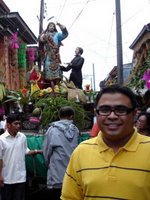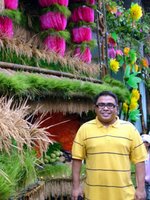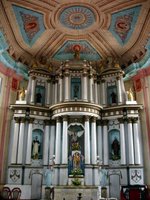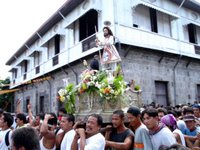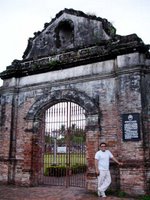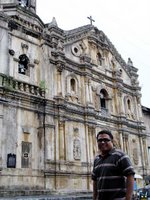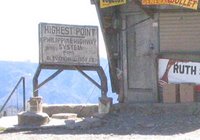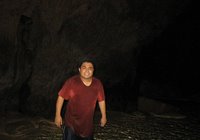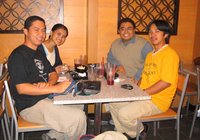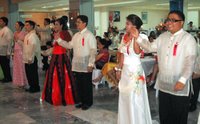It was two straight days of road trips for me. I just got back from Baguio City last night where members of the Heritage Conservation Society met with the management of Teachers' Camp and DepEd to discuss the restoration of Roxas Hall, the first in a large complex of heritage educational structures in Teachers' Camp that we all hope to restore by the centennial of the camp in 2008.
The van passed by for me in San Fernando at about 6 a.m. and we were off to Baguio. Along the way, we saw sad sights. Two of the best preserved examples of
municipios along MacArthur Highway, in fact I feel they were the ones with character, were renovated beyond recognition. Shame on the municipal governments of Moncada, Tarlac and Villasis, Pangasinan for destroying the unique character of their municipal halls and thus, the identity of their communities. Elections are fast approaching and we all know that LGUs are rushing to complete as many projects as they can, no matter how useless, to beat the election ban on projects. I wonder why? Hehe! I had seen the same structures the previous day when Ryan Tan and myself drove to Villasis, Pangasinan. From Rosales, we went to Cabanatuan City and along the way, I saw another sad sight. Let me add to the shame list Guimba, Nueva Ecija which replaced a charming early-American period wooden
presidencia with a concrete structure! These ignorant local officials don't realize the damage they are creating.

Anyway, we arrived in Baguio at about 11 a.m. and went straight to Teachers' Camp which was in full bloom. It was such a charming place except for the area which was lent to the Philippine Sports Commission (I heard they renovated a heritage structure without the permission of the Teachers' Camp mangement), and that ugly new building beside Roxas Hall which I heard GMA just inaugurated this Holy Week. For crying out loud, let's keep the character of Baguio City's green and white architecture alive, especially in well-preserved areas like Teachers' Camp!

Our architects have for months been making an assessment of the state of Roxas Hall (right) and we made a brief tour of the structure to inspect all the deterioration they found and the work which needed to be done.
After the tour, we proceeded to Cafe by the Ruins where Councilor Galo Weygan was going to meet us for lunch to discuss the proposed restoration of the Dominican Hill. The ruins here refer to what's left of the home of the owner of the cafe which was bombed during the Second World War. The cafe is a perfect mix of art and pocket gardens that you woudn't even notice that the busy street is just outside. For lunch, I had camote soup and chicken with coconut milk and basil, accompanied with
lassi, a yogurt drink which is mixed with fruits, strawberries in my case.

Councilor Weygan asked us what could be done to the structure on Dominican Hill. Gemma stressed that unless they have the extra funds to spend, they have to make heritage commercially viable and self-sustaining. Which is why, instead of the museum the City Government of Baguio was thinking of, we proposed that it be used again as a hotel (it was a hotel before) with a lot of outdoor cafes which non-guests could also visit and enjoy given the magnificent views of Baguio from the hill. We were going to visit the site later in the afternoon after we finished our meeting at Teachers' Camp.
One of the things discussed as well was the pending
Baguio Heritage Ordinance which I heard was already passed on second reading. It aims to preserve what is left of the unique fabric of Baguio City and its character architecture (green roofs and white or brown walls) by convincing existing homeowners whose homes can be seen in heritage view areas such as Kennon Road, Teachers' Camp,
Camp John Hay among others, to paint their houses green and white. We must remember that each place on earth has a unique character (towns in the Philippines are losing theirs thanks to the ignorance of local officials and priests). When you see white houses on cliffs beside blue water, you know you are in the Mediterranean. It should have been that when one saw green and white houses and buildings harmoniously mixed with lush pine trees, he knew that he was in Baguio City. But that is not the case today since the city's most imposing landmark is no longer the Baguio Cathedral or Burnham Park; it is now SM City Baguio! Sigh!
I think Henry Sy should read this
article in
The Wall Street Journal about how China is starting to realize that preserving archaeological sites may be a better idea than building shopping malls. I remember this article well since I got to read it during my first few weeks in UP MBA thanks to the free issues of The Asian Wall Street Journal.
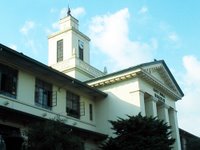
Anyway, on the way out of the cafe, we bought some bread to take back home to Manila. I got some blueberry muffins, basil bread, camote bread and carrot cake. We were then off to our meeting back in Teachers' Camp.
After the meeting, we met up with Councilor Weygan at Baguio City Hall which is another heritage landmark of the city. At the base of the building was the signature pink Baguio stone which once became a fad in Manila. We then proceeded to Dominican Hill from there.
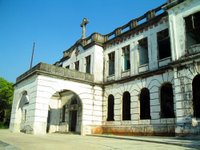
The hill was very near the Lourdes Grotto. The setting was just excellent! From the gate, we could see that the old structure on the hill used to be very stately and elegant. Indeed, the Dominicans selected the best sites for their buildings. But after continuous looting, we all knew that the site needed massive restoration work.
We could all imagine however what it would look like when completed... a charming lobby with a fireplace, outdoor cafes at the roof deck and the sides of the building serving local food and coffee, three floors of comfortable rooms and a magnificent view of the surrounding areas. The photo below was taken from the spacious roof deck of the building. Check out
Melvin Pawataran's photos of Dominican Hill.
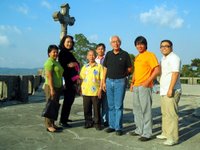
After the brief visit, it was back to the lowlands for us. I had wanted to stay in Baguio since I had forgotten it was still summer thanks to the cool temperature. It would have been such a charming city had previous local officials protected the unique cultural fabric and character of the city. Today, we no longer smell pine trees but exhaust from jeeps and other vehicles. But it is never too late since there is still a lot than can be preserved. Baguio City should prevent another SM disaster from happening again by controlling the achitecture, height and colors of new buildings, ensuring that they are in harmony with exisitng buildings, by making sure that no more pine trees are chopped down (SM City Baguio had to chop down hundreds of pine trees FYI) and by convincing existing homeowners to repaint their houses greena and white or use local stones on the walls such as Baguio pink, Kennon gray and Irisan white.
Related to the upland heritage, the
Rice Terraces of the Cordilleras may be removed from the UNESCO World Heritage list. The
article came out recently in
SunStar Baguio. Take note of what the municipal engineer of Banaue said under the subtitle
Emergency meetings. It is that type of ignorance in the guise of practicality which continuously destroys the heritage of the Philippines.
 When was the last time you displayed the Philippine flag outside your home? According to Section 7 of RA 8491 - An Act Prescribing the Code of the National Flag, Anthem, Motto, Coat-of-Arms and other Heraldic Items and Devices of the Philippines:
When was the last time you displayed the Philippine flag outside your home? According to Section 7 of RA 8491 - An Act Prescribing the Code of the National Flag, Anthem, Motto, Coat-of-Arms and other Heraldic Items and Devices of the Philippines:








